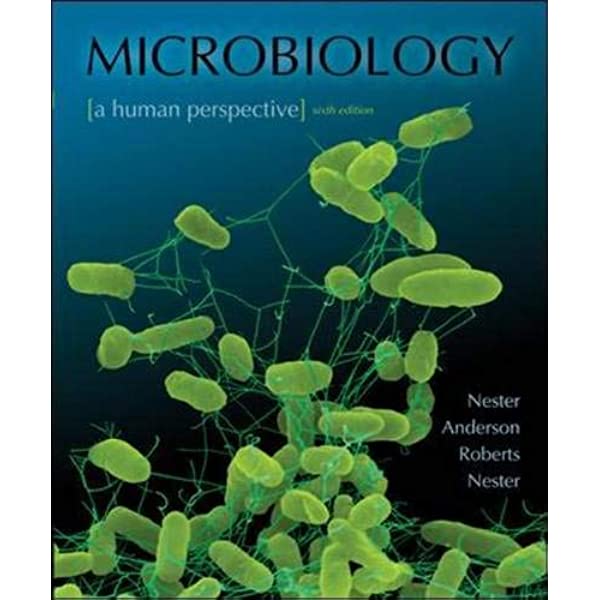Test Bank Microbiology Human Perspective 6th Edition by Nester Anderson Roberts
Original price was: $55.00.$19.00Current price is: $19.00.
Digital item No Waiting Time Instant Download
ISBN-10: 0077250419 ISBN-13: 978-0077250416
Publisher : McGraw-Hill Science/Engineering
/Math; 6th edition
Authors: Eugene Nester, Denise Anderson, C. Evans Roberts,
Jr., Martha Nester
Description
Test Bank Microbiology Human Perspective 6th Edition by Nester Anderson Roberts
Chapter 01
Humans and the Microbial World
Multiple Choice Questions
1. The scientist usually considered the first to see microorganisms, which he called “animalcules”, was
A. Redi
B. van Leeuwenhoek
C. Pasteur
D. Tyndall
2. The word “Animalcule” was coined by
A. Pasteur.
B. van Leeuwenhoek.
C. Redi.
D. Tyndall.
3. The idea of Spontaneous Generation postulated that
A. organisms could evolve into the next generation of organisms.
B. organisms could spontaneously combust.
C. organisms could spontaneously arise from other living organisms.
D. living organisms could spontaneously arise from non-living material.
4. Which of these scientist(s) was/were involved in, among other things, investigating the idea of spontaneous generation?
A. Redi
B. van Leeuwenhoek
C. Pasteur
D. Escherich
E. Redi AND Pasteur
5. The work of Tyndall and Cohn
A. supported the idea of spontaneous generation.
B. was used to explain why others investigating spontaneous generation had obtained results that were opposite of those obtained by Pasteur.
C. showed that microbes caused disease.
D. allowed scientists to see microorganisms.
6. The structures present in the hay infusions used in experiments on Spontaneous Generation that made them difficult to sterilize are
A. chlorophyll.
B. toxins.
C. organelles.
D. endospores.
7. The opposite results obtained by scientists apparently doing the same experiments in investigating spontaneous generation
A. shows the importance of repeating experiments.
B. shows the importance of exactly duplicating experimental conditions.
C. led to further experiments that ultimately furthered knowledge.
D. All of the choices are correct.
8. If while investigating Spontaneous Generation, Pasteur had his laboratory located in a stable
A. the results would, most likely, have supported the idea of spontaneous generation.
B. the results would, most likely, have not supported the idea of spontaneous generation.
C. this would have had no effect on his results.
D. this would have shown his love of horses.
9. Cellulose is a major component of plants and is only directly digested by
A. herbivores.
B. carnivores.
C. termites.
D. microorganisms.
10. Plants are dependent on microorganisms
A. providing oxygen.
B. providing water.
C. changing atmospheric nitrogen to a usable form.
D. providing carbohydrates.
11. Microorganisms are involved in
A. causing disease.
B. curing/treating disease.
C. preparing food.
D. cleaning up pollutants.
E. All of the choices are correct.
12. Bacteria have been used for food products
A. for several thousand years.
B. since the middle ages.
C. since the late 1800s
D. since the 1950s
13. Microorganisms are involved in
A. production of medicinal products.
B. transforming atmospheric nitrogen to a form useful to plants.
C. food production.
D. pollution cleanup.
E. All of the choices are correct.
14. Bioremediation refers to
A. rehabilitating wayward bacteria.
B. using bacteria to clean up pollutants.
C. vaccine development.
D. monitoring newly discovered disease organisms.
15. The Golden Age of Medical Microbiology
A. occurred during the late 1800’s to early 1900’s.
B. started in the 1990’s with the advent of genetic engineering.
C. is a time when the knowledge of and techniques to work with bacteria blossomed.
D. was when people realized that diseases could be caused by invisible agents.
E. occurred during the late 1800’s to early 1900’s, is a time when the knowledge of and techniques to work with bacteria blossomed AND was when people realized that diseases could be caused by invisible agents.




Be the first to review “Test Bank Microbiology Human Perspective 6th Edition by Nester Anderson Roberts”